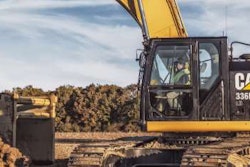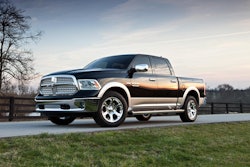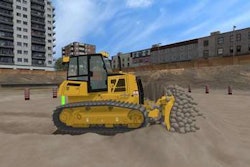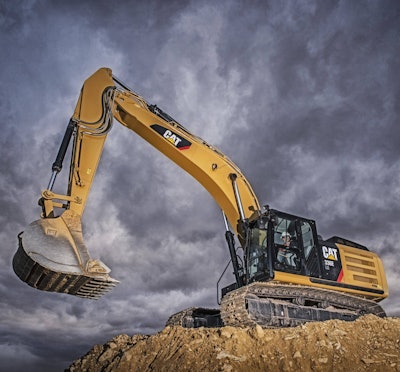
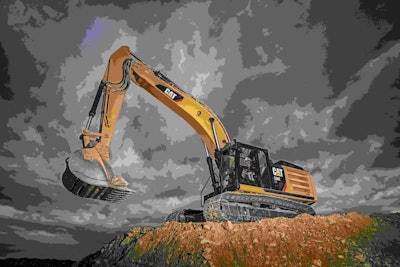
The feel of operation
Hybrid, in many minds, means electrical. But the 336E H is what Cat calls a hydraulic hybrid. Like electrical hybrids, it captures and reuses energy, but rather than reuse energy in the form of electricity, it uses hydraulic accumulators built into the counterweight to store swing braking energy and rerelease it on the return to dig cycle.
And what a difference that makes. Instead of the complexity and cost of electrical generators and motors and cabling, the Cat 336E H uses technology that everybody knows and can feel comfortable with—hydraulics.
It’s a fast, powerful and surprisingly quiet machine.
One of Cat’s goals with the new system was to make sure the 336E H had identical performance to the non-hydraulic hybrid models. The company had to overcome the perception in many minds that the term “hybrid” didn’t also mean some kind of compromise or constrained performance.
And after 10 minutes of digging with the machine that becomes abundantly clear. It’s a fast, powerful and surprisingly quiet machine. Inside the cab with the door shut it’s quiet enough that you could hold a conversation on your cell phone without shouting or idling the machine.
What makes a hybrid
At the heart of the hydraulic hybrid system are three components:
- A large displacement, electronic, programmable pump. This is the same hydraulic pump and cylinder pack found in other Cat machines, just repurposed for the excavator.
- An adaptive control system valve. This is the brains of the system, giving you independent control of functions that used to work as one. “It tells the fluid where to go,” says Ken Gray, global product manager, for Cat’s large hydraulic excavators. “It takes the power and distributes it most efficiently, only when needed, only where needed.” The ACS valve independently manages inflow and outflow restrictions to and from each circuit of the machine to maximize performance. No extra valves are necessary for in-cylinder flow regeneration of the boom, stick or bucket. And it eliminates the fine swing control value but maintains this functionality. If anything is new to this system it’s this ACS valve and the algorithms that control its processes.
- Hydraulic hybrid swing system. This is a pair of big nitrogen gas accumulators that absorb the energy that goes into stopping the swing rotations and then reuses that energy it on on the return to dig cycle. “Gas over oil accumulators are nothing new,” says Gray. “They’re used in steering and other systems.

Fuel economy, return on investment
The goal in all of this is to conserve fuel, optimize performance and reuse energy. Cat is claiming some big numbers when it comes to the fuel efficiency—up to 25 percent less fuel consumption than the conventional 336E excavator and up to 50 percent less fuel consumption than a 336D series.
The fuel savings comes partly from recapturing much of the swing and braking energy but also because the ACS valve allows Cat to reset the operating rpm on the C9 engine from 1,800 to 1,500 rpm.
The price premium…is about 9 percent
The lowered rpms also help reduce the noise level of the machine, but don’t compromise the performance thanks to the ACS valve. The swing and digging speeds were all kept the same as the 336D and E series, Gray says.
The price premium for the hydraulic version of the 336 is about 9 percent, says Gray. But in today’s fuel costs that extra expense can be recouped in as little as one year for machines in a high production environment, roughly 2,000 hours a year. The average user more typically puts about 1,400 hours a year on an excavator of this size, Gray says, in which case the payback period would average about 18 months.
More hybrids in the Cat pipeline
Gray says the 336E H is only the first of what likely will be many machines that will use Cat’s hydraulic hybrid technology. Plans are already underway to offer a 336F H and 336D H. The new hydraulic technology is also appropriate to larger excavators, and wheel loaders are another possible candidate for the system, he says. Gray added that for smaller excavators, the ROI might not be as substantial as with the bigger models, hence smaller excavators in the future may not incorporate the hydraulic hybrid system.
And ROI is what’s going to make the technology succesful with contractor’s Gray said. In focus groups, contractors consistently told him they are most interested in reliability and productivity, not their carbon footprint. They also told him they didn’t want a seven year payback period or a technology that was complicated to maintain or support.
“That’s what drove us to this design,” Gray says. Cat had actually started down the hybrid path with an electric hybrid concept, and kept the hydraulic hybrid development moving down a parallel track but in a skunk works type program. But the performance, price and familiarity of the hydraulic system won out in the end and the electric hybrid design was shelved.
The 336E H is currently being manufactured in Japan, but eventually production will be moved to Cat’s new excavator plant in Victoria, Texas. The machine is available in North America, Europe and Japan, basically countries that have ultra low sulfur diesel and emissions requirements. U.S. dealers began talking orders in March.

